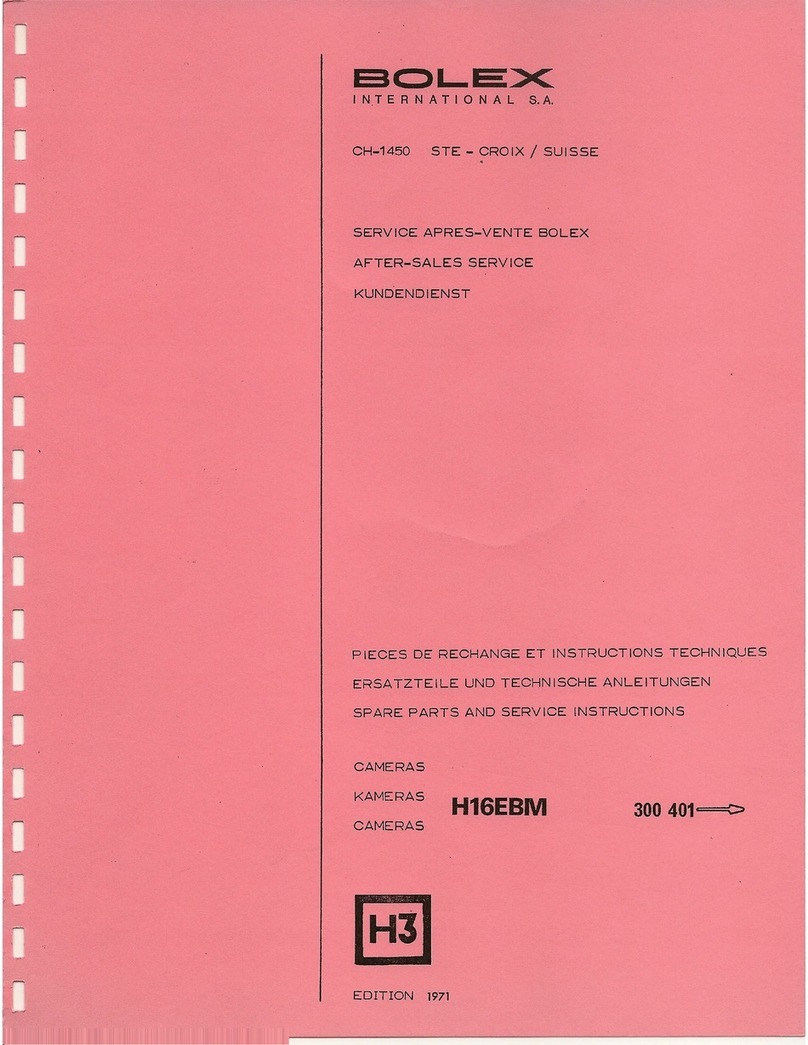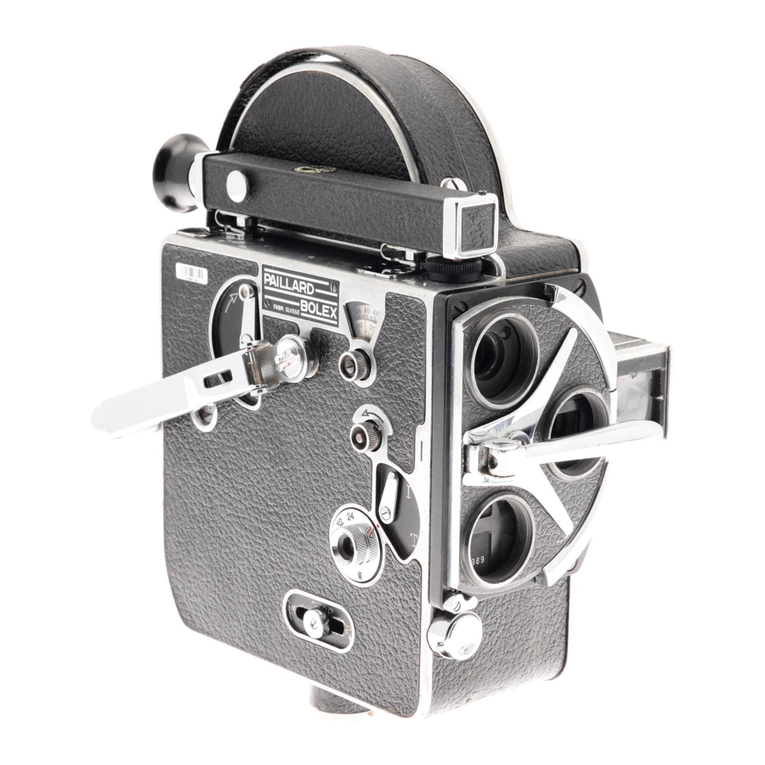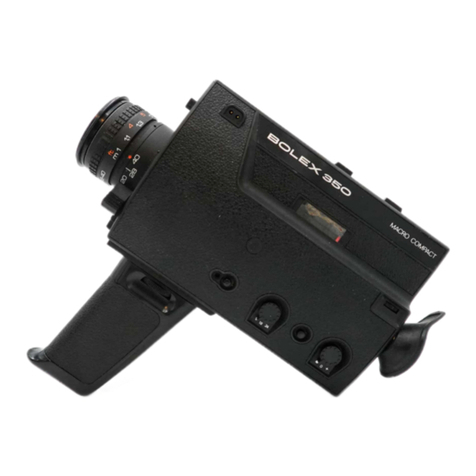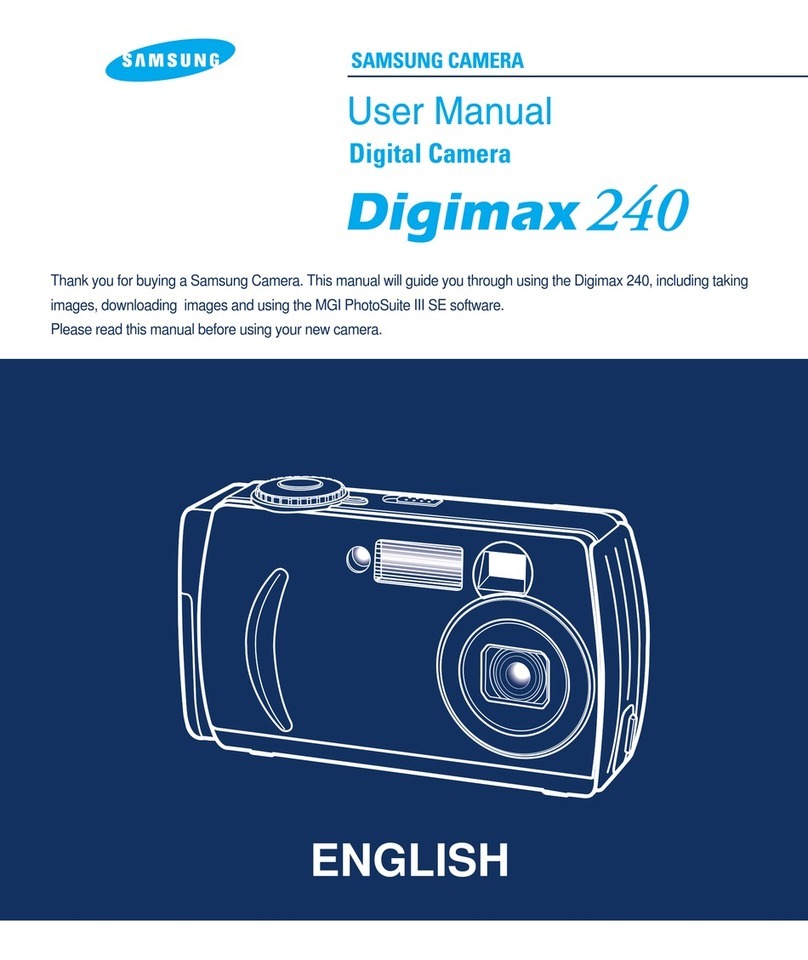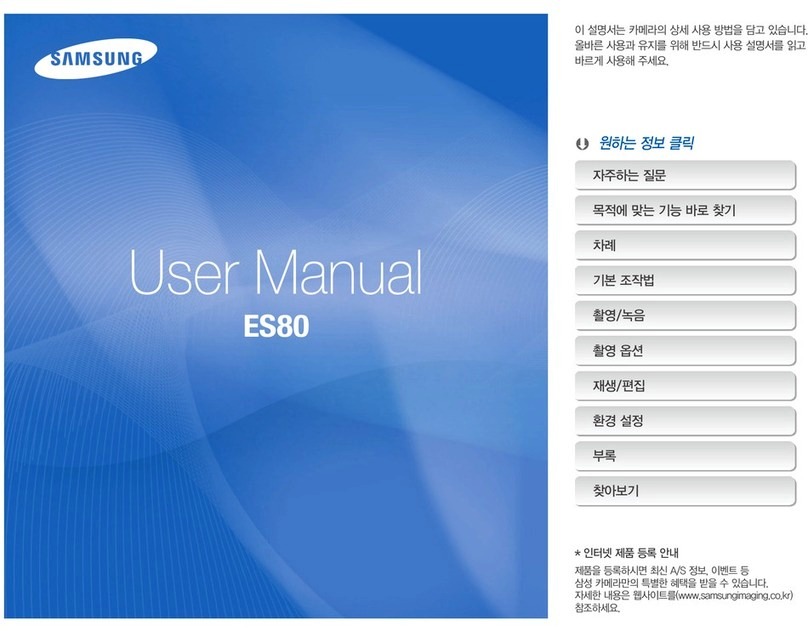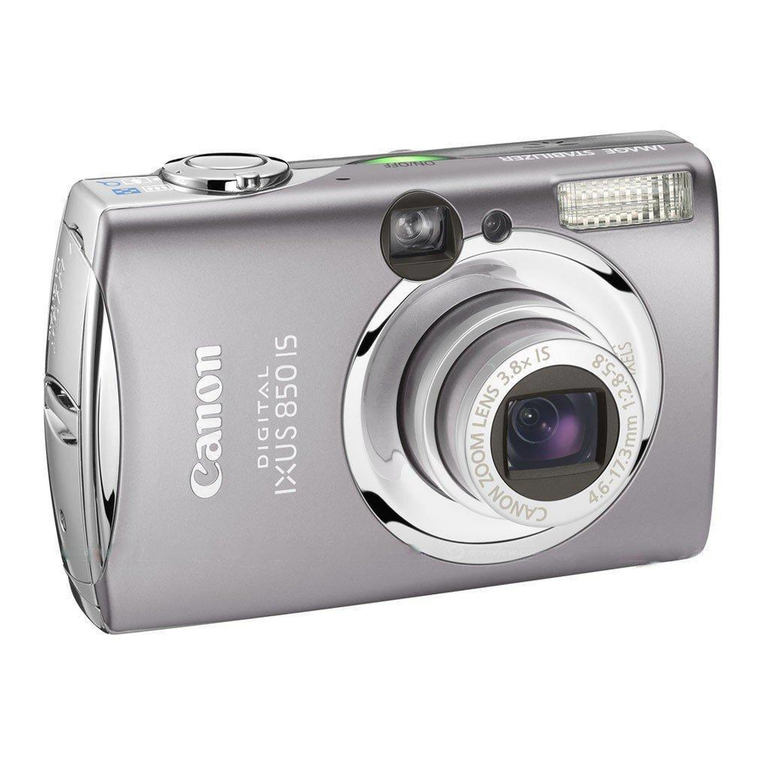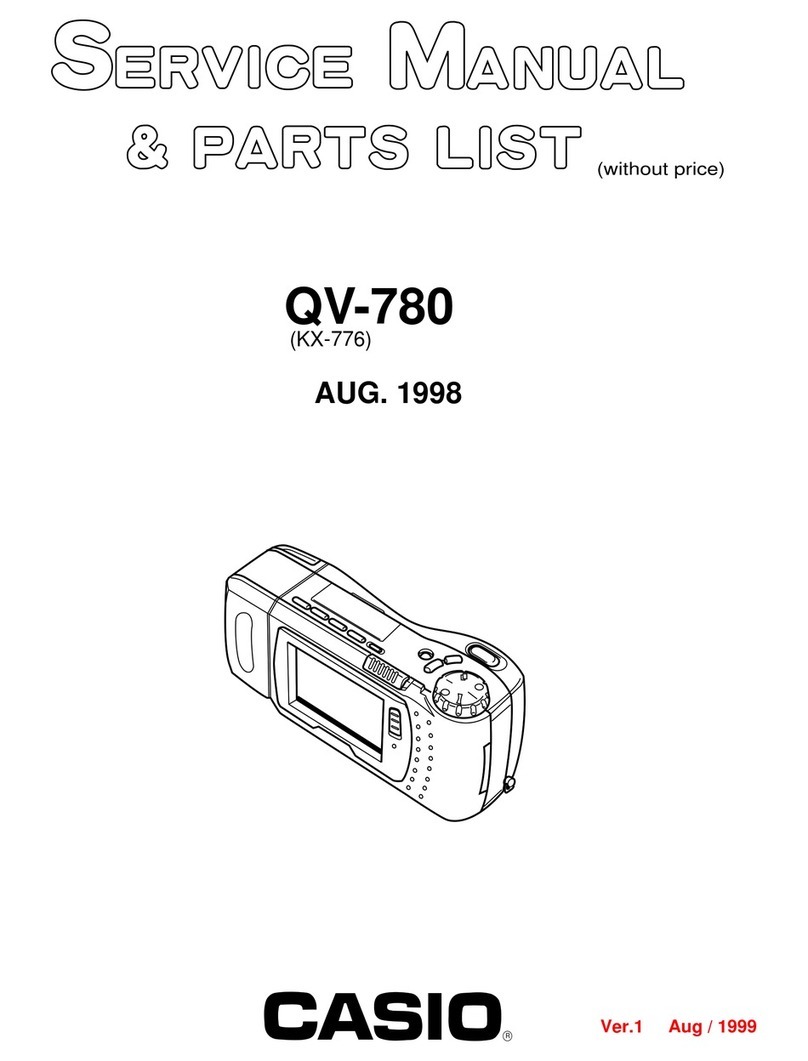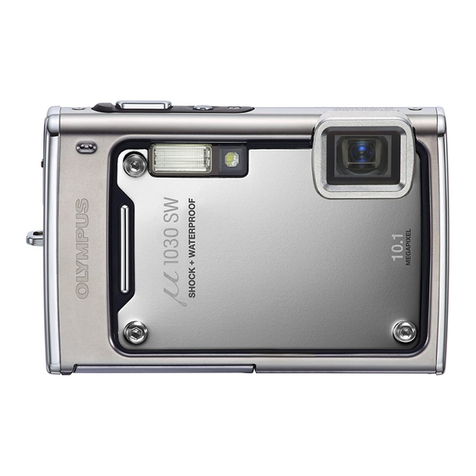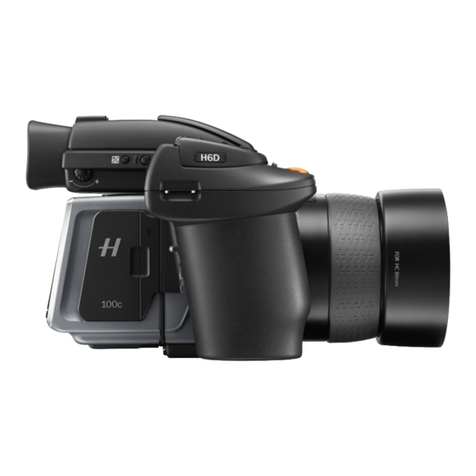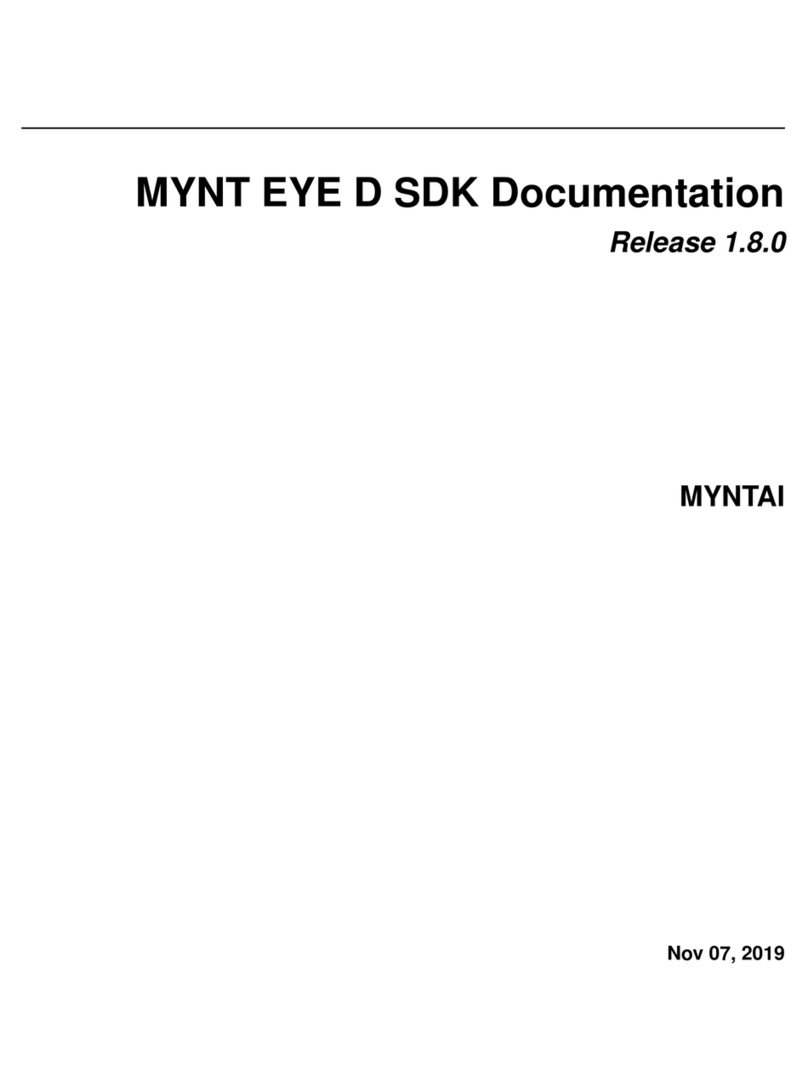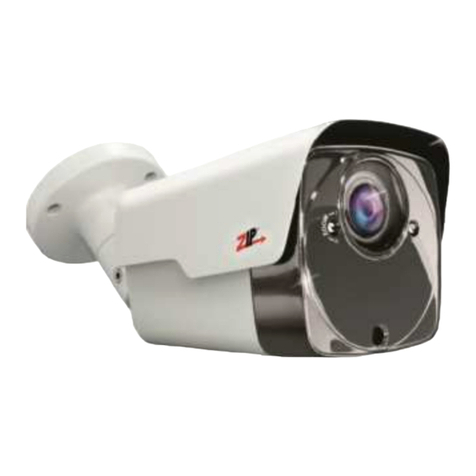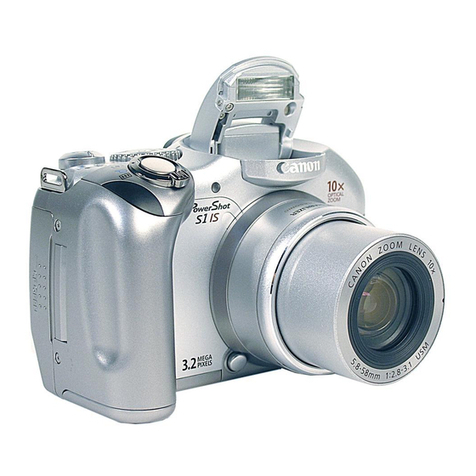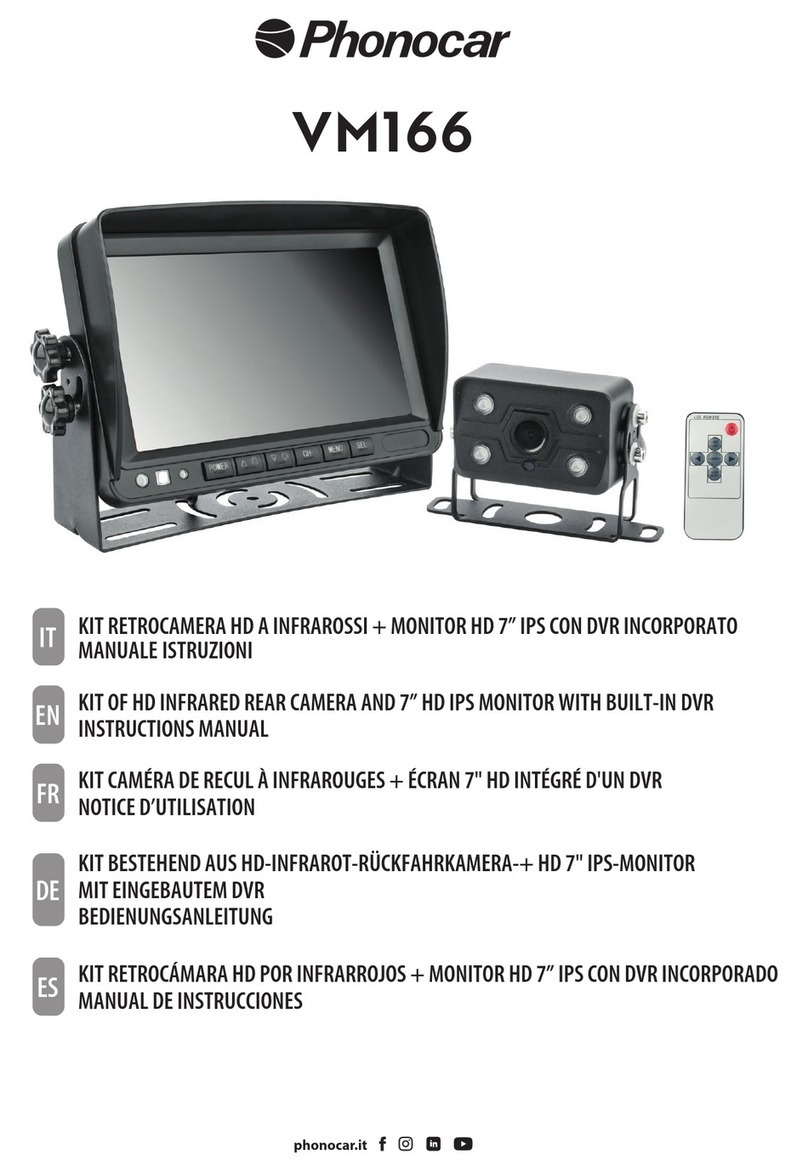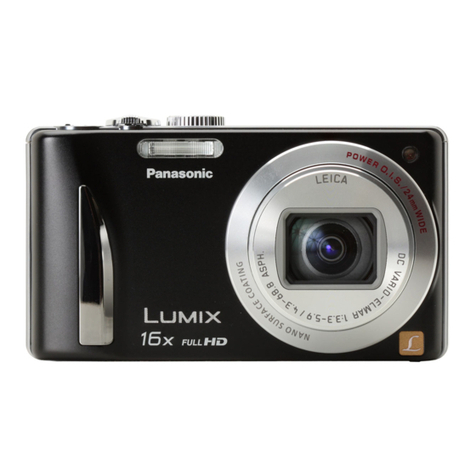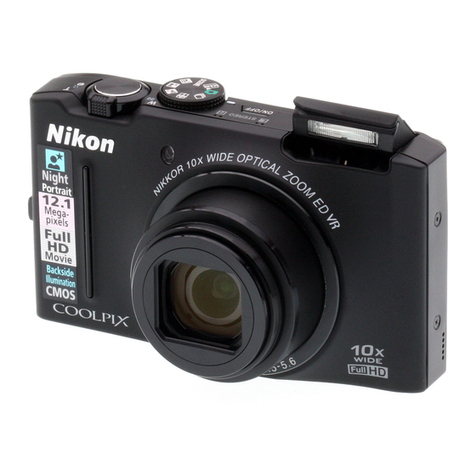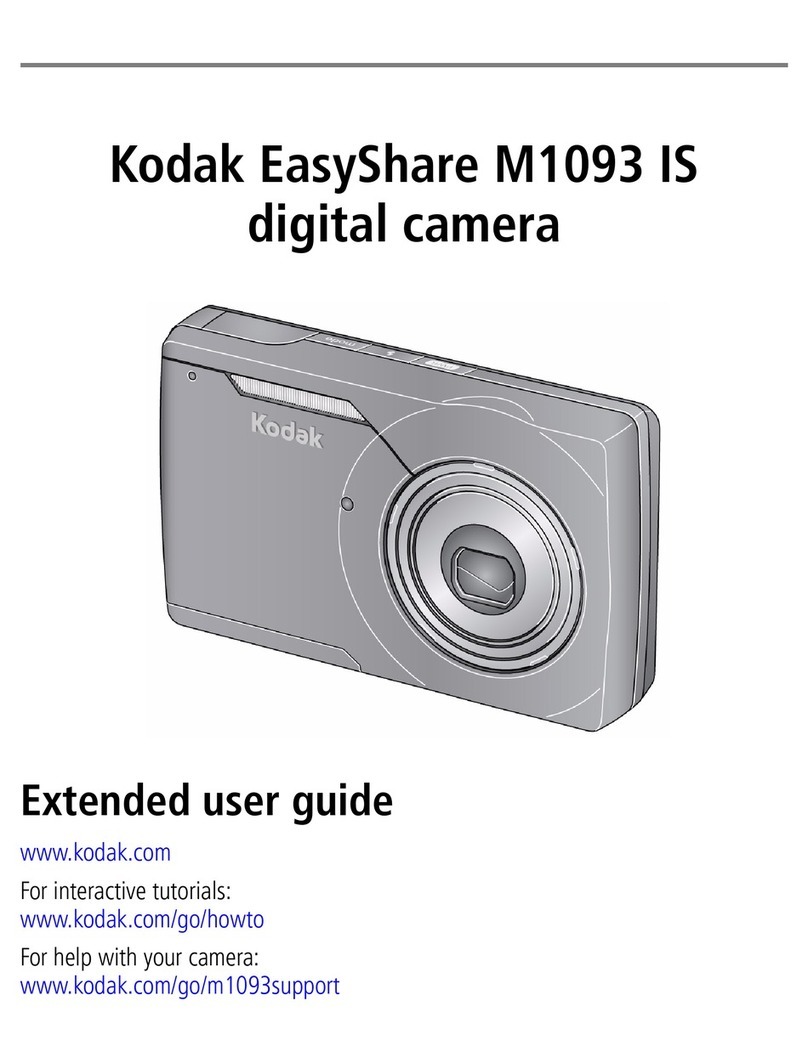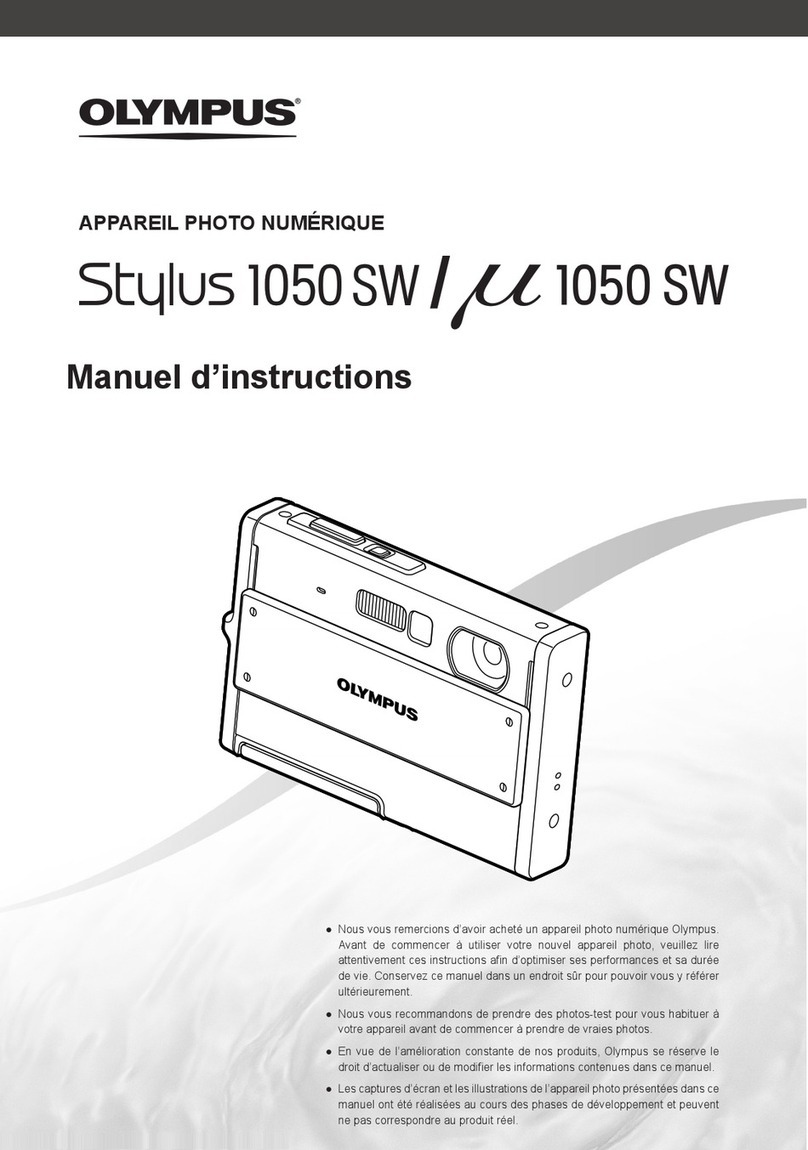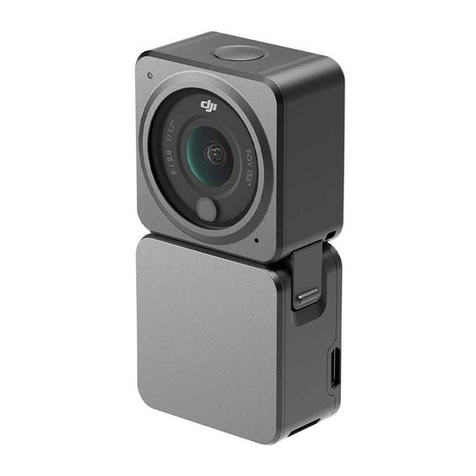BOLEX D8LA User manual

D8LA
CAMERA

FOREWORD
You
are
now
the
lucky
owner
of
a
distinguished
camera.
The
name
BOLEX
is
known
throughout
the
world
as
a
hallmark
of
technical
perfection
and
precision
craftsmanship
—
Swiss
watch-making
precision
par
excellence.
Your
BOLEX
D8LA
camera,
of
course,
includes
an
electric
eye
which
is
situated
behind
the
lens.
In
addition
it
has
other,
even
newer
features.
A
new
ultra
sensitive
exposure
meter
further
improves
its
handling
qualities,
and
a
perfected
rewinding
system
en¬
ables
you
to
achieve
outstanding
visual
effects.
But
before
getting
to
work
with
your
BOLEX
D8LA
camera
and
whenever
you
have
any
doubts,
consult
this
instruction
manual
carefully.
It
will
serve
you
as
an
aid
for
better
movies.
PAILLARD
S.A.
Sainte-Croix
(Switzerland)
2

Pages
Foreword
2
Get
to
Know
Your
Camera
4
Howto
Load
Your
Camera
-
Winding
6
Film
Footage
Counter
8
How
to
Invert
Your
Film
and
Unload
Your
Camera
9
Filming
Speeds
10
Release
Selector
11
Viewfinder
12
CONTENTS
Parallax
Correction
13
Lenses
14
Distance
Setting
16
The
Depth
of
Field
17
Variable
Shutter
18
Fade-in
19
Fade-out
-
Lap
Dissolve
-
Rewinding
the
Film
20
To
Produce
a
Lap
Dissolve
21
Setting
the
Diaphragm
22
Checking
the
exposure
meter
Adjustement
26
Some
Words
of
Advice
before
Shooting
27
Filters
-
Lens
Hoods
28
Upkeep
29
Exposure
Times
31
18-5
Projector
32
3

Winding
key
(page
6)
Turret
(page
14)
Exposure
meter
(page
23)
Shooting
lens
(page
14)
Additional
lens
(page
14)
Additional
lens
(page
14)
Release
(page
11)
Cable
release
socket
Control
of
variable
shutter
(page
18)
Viewfinder
setting
(page
12)
Release
selector
(page
11)
Rewinding
handcrank
lodging
(page
20)
Serial
number
Socket
fortrigger
handle,
wriststrap
or
tripod
(page
27)
Filming
speed
setting
(page
10)
4
^
=
Notch
symbol
indicating
film
plane
inside
camera
4

Door
lock
(page
8)
First
and
second
loading
indicator
(page
8)
Viewfinder
(page
12)
GET
TO
KNOW
YOUR
CAMERA
Index
number
calculator
(page
22)
Film
footage
counter
(page
8)

HOW
TO
LOAD
YOUR
CAMERA
Before
loading
your
camera,
try
out
the
important
controls
without
film:
winding,
release
selector,
filming
speeds,
variable
shutter,
rewinding,
functioning
of
the
built-in
lightmeter,
release.
Familiarize
yourself
with
your
camera
in
order
to
avoid
wasting
film.
While
It
is
not
difficult
to
operate
the
camera,
a
certain
amount
of
experience
is
necessarily
required
for
good
results.
Important
—
When
your
camera
Is
not
loaded,
never
let
it
run
at
more
than
32
f.p.s.,
as
this
could
cause
damage
to
the
mechanism.
WINDING
Lift
the
winding
key
and
move
it
back
and
forth
until
a
definite
stopping
point
is
reached.
The
motor
is
now
fully
wound
and
will
run
off
about
7
ft.
of
film.
This
gives
you
about
31
seconds
of
filming
at
a
speed
of
18
frames
per
second.
To
prevent
the
motor
running
down
during
an
Important
shot
It
is
advisable
to
re-wind
after
every
shooting.
To
avoid
any
risk
of
fogging
the
film,
the
camera
should
be
loaded
in
the
shade,
or
better,
in
semi-darkness.
TO
OPEN
THE
CAMERA
Lift
up
the
hinged
semicircular
ring,
turn
it
to
position
O
and
lift
the
door.

2
3
4
TO
INSERT
THE
FILM
INTO
YOUR
CAMERA
Place
the
open
camera
with
the
hinged
door
towards
you
and
open
the
pressure-pad
by
moving
the
lever
(fig.
1).
Remove
the
empty
spool
from
the
camera.
Hold
the
full
spool
In
your
right
hand
In
such
a
manner
that
the
filrn
cannot
become
loose.
Unwind
about
10
inches
of
film,
and
slip
the
full
spool
on
its
spindle,
guiding
the
film
through
the
gate
as
illustrated
(fig.
2).
Close
the
pressure-pad
by
pushing
the
lever
while
holding
the
full
spool
in
Its
place
with
your
right
hand
(fig.
3).
(A
safety
device
makes
it
Impossible
to
close
the
door
unless
the
pressure-pad
is
closed.)
Now
take
the
empty
spool
with
the
side
marked
I
facing
you
and
insert
the
end
of
the
film
into
the
slit
which
is
below
the
mark
I
(fig.
4).
Wind
2
to
3
turns
of
film
on
the
spool,
rotating
it
in
a
clockwise
manner.
Place
the
take-up
spool
on
its
spindle
disregardingthe
position
of
the
notches
(fig.
5).
The
dark,
shiny
side
of
the
film
must
be
facing
towards
you,
and
the
light
side
towards
the
lens.
li
ij
i!
ii
I
7

Before
closing
the
camera
door,
press
the
release
for
a
fraction
of
a
second
to
check
that
film
is
running
correctly.
Now
close
the
door
and
lock
it
by
turning
the
semicircular
ring
to
F.
Push
the
ring
back
so
that
the
single
point
mark
is
uncovered
to
indicate
that
the
film
is
on
its
first
25
ft.
run.
N.
B.
When
the
first
half
of
your
double-run
film
has
been
exposed,
turn
the
film
over
in
order
to
expose
the
other
half.
FILM
FOOTAGE
COUNTER
The
film
footage
counter
on
the
back
of
the
camera
automatically
indicates
the
amount
of
film
that
has
been
exposed.
The
film
being
loaded,
the
letters
ft.
(feet)
will
appear
behind
the
window,
because
the
indicator
automatically
returns
to
the
starting
point
when
the
pressure-pad
lever
Is
operated
in
the
course
of
loading
or
unloading
the
camera.
Press
the
release
and
run
the
film
until
the
figure
0
appears
opposite
the
white
notch.
The
4
ft.
film
leader
has
now
been
run
off.
8

HOW
TO
INVERT
YOUR
FILM
An
audible
end-of-film
signal
indicates
that
the
full
length
of
the
film
has
now
been
exposed
(the
indicator
shows
25
ft.).
The
spool
should
now
be
turned
over
to
expose
the
other
half
of
the
film.
Proceed
as
follows:
The
motor
should
be
allowed
to
run
until
10
clicks
of
the
audible
warning
signal
have
been
counted.
The
trailer
is
now
fully
wound
on
the
take-up
spool.
Open
the
camera
out
of
the
direct
rays
of
the
sun,
as
otherwise
there
is
a
risk
that
the
film
may
be
partly
fogged.
The
two
spools
may
then
be
taken
out
and
the
camera
can
be
reloaded
by
placing
the
full
spool
on
the
upper
(film
feed)
spindle,
with
the
side
marked
II
uppermost.
After
closing
the
camera
door,
push
the
semicircular
ring
back
so
as
to
leave
the
2
points
uncovered
to
indicate
that
the
film
is
on
its
second
25
ft.
run.
HOW
TO
UNLOAD
YOUR
CAMERA
When
the
film
has
been
fully
exposed,
the
original
BOLEX
spool
supplied
with
the
camera,
now
on
the
upper
spindle,
will
be
empty
again.
Remove
the
full
spool,
observing
the
same
caution
as
you
did
while
inverting
the
film.
Send
It
to
the
processing
laboratory
in
accordance
with
the
manufacturer’s
instructions.
9

FILMING
SPEEDS
The
speed
control
dial
has
seven
settings
—
12,
16,
18,
24,
32,
48
and
64
frames
per
second.
The
usual
filming
speed
nowadays
is
18
frames
per
second.
It
replaces
16
f.p.s.
as
the
international
standard
for
filming
as
well
as
for
screening.
Movements
are
reproduced
smoother
and
if
a
magnetic
sound
track
is
to
be
added
to
the
film,
the
sound
will
be
purer
and
clearer.
When
the
film
is
projected
at
normal
speed,
films
shot
at
a
slower
speed
(12
f.p.s.)
produce
an
illusion
of
acceler¬
ated
motion
on
the
screen,
while
films
shot
at
higher
speeds
(24/64
f.p.s.)
will
produce
a
slow
motion
effect.
To
set
filming
speed,
rotate
speed
control
dial
to
corresponding
setting
in
front
of
the
notch.
Do
not
forget
that
altering
the
filming
speed
necessitates
a
change
of
diaphragm.
Therefore,
adjust
the
exposure
meter
guidemark
(see
page
23).
10

RELEASE
SELECTOR
According
to
the
effect
desired,
use
either
normal,
continuous
running
or
single-frame
exposures.
These
are
controlled
by
the
release
selector
which
also
locks
the
camera:
O
Locked
camera
Normal
position
when
the
camera
is
not
in
use.
Q
Single-frame
exposure
Used
for
titles,
cartoons,
scientific
films,
trick
effects,
extreme
speed-ups
(clouds,
sunsets,
comical
effects,
etc.).
The
exposure
is
made
as
the
release
is
fully
pressed.
Q
Normal
running
Normal
filming
position.
The
camera
runs
as
long
as
you
press
the
release
fully.
O
Continuous
running
When
the
camera
is
running
normally,
push
the
release
selector
downwards.
The
camera
will
run
as
long
as
the
motor
is
wound.
Used
mainly
for
self-filming.
Cable
Release:
see
page
4.
Exposure
times:
see
table
page
31.
11

VIEWFINDER
The
viewfinder
allows
you
to
choosetheframing
best
suited
to
the
scene
to
be
shot.
The
viewfinder
is
continuously
adjustable
by
means
of
a
knob
to
match
the
field
covered
by
lenses
of
12.5
(standard)
to
36
mm
(telephoto)
focal
length.
Because
the
needles
of
the
exposure
meter
only
appear
perfectly
sharp
at
the
12.5
mm
setting,
frames
corresponding
to
the
focal
lengths
of
25
mm
(outer
frame)
and
36
mm
(inner
frame)
have
been
engraved
on
the
aperture
to
permit
you
to
determine
the
exact
field
of
view
for
telephoto
lenses
even
when
the
viewfinder
control
button
is
left
on
position
12.5.
The
lever
(L)
(field
adapter)
controls
a
flip-up
element
placed
inside
the
exposure
meter
housing.
When
In
vertical
position,
it
adjusts
the
viewfinder
field
to
match
the
field
of
a
5.5
mm
wide
angle
lens
while
the
viewfinder
control
button
remains
on
position
12.5.
12

The
circle
which
then
shows
inside
the
field
of
view
serves
as
a
reminder
that
the
flip-up
element
is
in
action.
To
adapt
the
viewfinder
for
movie
makers
who
wear
glasses,
the
viewfinder
eyepiece
can
be
replaced
by
a
special
lens.
Any
enquiries
should
be
addressed
to
the
BOLEX
distributor
through
your
dealer,
specifying
the
strength
required
in
diopters.
PARALLAX
CORRECTION
The
area
covered
by
the
lens
is
slightly
different
from
the
area
seen
by
the
viewfinder;
this
difference
is
called
parallax.
Parallax
becomes
noticeable
in
shots
taken
at
short
distances
(i.
e.
less
than
5
ft.
with
a
standard
lens).
For
exact
correction
of
the
parallax,
use
a
parallax
corrector
prism
over
the
exposure
meter
aperture.
Four
parallax
corrector
prisms
are
supplied
in
pairs,
either
for
25
and
50
cm
or
for
1
and
2
ft.
(30
and
60
cm).
The
subject
to
be
filmed
can
also
be
framed
with
the
help
of
the
upright
and
the
table
of
the
BOLEX
8
mm
titler.
13

I
LENSES
Your
camera
takes
a
wide
range
of
standard
mount
lenses:
—
standard
lenses
(12.5
mm
or
13
mm)
for
ordinary
shots.
Give
normal
perspective;
—
wide-angle
lenses
(5.5
mm
to
6.5
mm)
for
long
shots
or
when
it
is
difficult
to
stand
back
from
the
subject
(buildings,
interiors,
etc.).
Give
heightened
perspective;
—
telephoto
lenses
(25
mm
to
36
mm),
for
close-up
shots
of
more
or
less
distant
subjects;
also
produce
very
effective
extreme
close-ups.
Give
flattened
perspective.
i
The
lenses
can
be
Interchanged.
However,
it
is
prefer¬
able
to
screw
wide-angle
lenses
in
the
seat
indicated
by
an
engraved
dot.

Screw
the
lenses
into
their
mount,
holding
them
by
the
fastening
ring
A.
Another
ring
adjusts
the
diaphragm;
in
other
words,
it
controls
the
amount
of
light
which
passes
through
the
lens
and
exposes
the
film.
Some
lenses
have
a
third
ring
which
is
used
for
focusing.
The
handling
of
the
diaphragm
ring
gets
easier
with
a
control
lever.
This
device
is
available
from
your
BOLEX
dealer.
To
complete
your
optical
equipment,
BOLEX
offers
you
zoom
lenses
(Pan
Cinor
40),
optical
attachments
such
as
Moller
anamorphic
lenses,
filter
sets
and
lens
hoods.
15

DISTANCE
SETTING
The
outstanding
quality
of
lenses
and
film
makes
It
possible
to
achieve
remarkable
sharpness
In
8-mm
filming.
In
sunny
weather,
with
a
standard
lens
set
at
6
ft,
you
can
obtain
a
sharp
picture
from
approximately
3
ft.
to
infinity.
standard
Lens
In
order
to
obtain
the
best
results
when
using
a
lens
with
an
adjustable
focusing
mount,
we
advise
you
to
esti¬
mate
the
average
distance
at
which
the
subject
will
be
filmed
and
to
adjust
the
focusing
ring
of
the
lens
accordingly.
On
the
Kern-Paillard
lenses,
a
red
number
Indicates
the
distance
most
frequently
used,
which
will
give
you
the
maximum
sharpness
from
foreground
to
background
in
average
circumstances.
For
close-ups
it
is,
however,
necessary
to
set
the
exact
distance
between
subject
and
film.
This
is
also
advisable
when
filming
with
a
telephoto
lens
or
with
the
lens
diaphragm
wide
open.
(For
example:
distance
of
3
ft.
or
less
and
diaphragm
set
to
2.8
or
less.)
The
distances
are
measured
from
the
film
plane
(see
page
4).
16

The
depth
of
field,
that
is
to
say
the
zone
in
which
the
subject
is
sharp,
varies
accord¬
ing
to
the
lens
focal
length,
diaphragm
aperture
and
film¬
ing
distance.
Visifocus
Scale
Mobile
Compass
With
a
long
focal
length
lens,
open
diaphragm
or
short
filming
distance
the
depth
of
field
is
shallow.
With
a
short
focal
length
lens,
closed
diaphragm
or
long
filming
distance
the
depth
of
field
Is
great.
On
most
lenses,
a
depth-of-field
scale
Indicates
the
limits
within
which
the
filmed
subject
will
be
sharp.
The
illustrations
show
two
Kern-Palllard
lenses,
one
with
the
“
Visifocus
”
scale
(orange
dots)
and
the
other
with
the
“
mobile
compass
”
(white
curve).
Lenses
are
always
supplied
with
a
depth-of-field
chart.
17

VARIABLE
SHUTTER
Your
camera
is
equipped
with
a
variable
shutter.
By
reducing
the
opening
angle,
the
film
ex¬
posure
time
is
reduced
proportionately
without
changing
the
filming
speed.
The
control
lever
can
be
moved
while
filming,
or
it
can
be
set
in
one
of
the
positions
shown
on
illustration
opposite.
The
shutter
can
be
locked
in
the
open
and
half-closed
positions
by
pushing
the
grooved
slide
(a
on
illustration
opposite)
in
the
direction
of
the
arrow.
Exposure
times
for
different
settings
of
the
variable
shutter
and
for
different
filming
speeds
are
listed
in
the
table
on
page
31.
18
3

USE
of
the
VARIABLE
SHUTTER
O
If
the
light
is
particularly
strong
(reflection
from
snow
or
water),
the
variable
shutter
can
be
adjusted
so
that
exposure
is
reduced
and
the
use
of
a
neutral
density
filter
becomes
unnecessary.
O
The
variable
shutter
increases
picture
sharpness
of
moving
subjects
by
reducing
the
exposure
time.
This
is
particularly
true
forfilms
shot
at
32
f.p.s.
or
more
(slow
motion).
On
the
other
hand,
if
filmed
at
normal
or
slower
speeds
with
the
variable
shutter
half-closed,
the
rapidly
moving
subject
will
seem
jerky
when
projected.
Q
The
variable
shutter
allows
you
to
produce
a
number
of
professional
effects
such
as
the
following.
a)
FADE-IN
A
fade-in
is
made
by
gradually
Increasing
the
exposure
of
a
shot
to
make
it
go
from
dark
to
normal
brightness
on
the
screen.
To
produce
a
fade-in,
start
from
the
position
as
illustrated;
(lever
at
extreme
right
notch
-
Letter
S
=
Stop);
press
the
release
and
turn
the
shutter
lever
smoothly
all
the
way
down
(symbol
Q
opposite
the
notch)
and
continue
filming.
As
a
rule,
this
operation
should
not
take
more
than
about
2
seconds.
N.
B.
The
camera
will
not
start
while
the
shutter
control
lever
Is
in
the
position
illustrated
(lever
at
extreme
right)
19

b)
FADE-OUT
A
fade-out
is
a
gradual
darkening
of
the
shot
until
it
has
disappeared
completely.
To
produce
a
fade-out,
the
same
procedure
as
for
a
fade-in
is
carried
out
in
reverse.
Start
with
the
shutter
lever
in
a
horizontal
position
(symbol
n
opposite
the
notch)
and
then
move
It
slowly
up
until
the
camera
stops.
NB
—
Fade
out
+
Fade-in
=
Transitional
Fade
c)
LAP
DISSOLVE
A
lap
dissolve
is
unquestionably
one
of
the
most
pleasing
transitional
effects
between
two
sequences
and
is
made
by
superimposing
a
fade-in
on
a
fade-out;
thus,
a
remarkably
soft
transition
is
achieved.
How
is
it
done
?
Although
the
variable
shutter
is
essential
for
this,
it
alone
is
not
enough.
A
special
rewinding
system
has
to
be
provided.
REWINDING
THE
FILM
Engage
the
small
hand
crank
in
Its
lodging
(see
illustration
page
4),
and
turn
clockwise.
As
each
frame
passes,
you
will
hear
a
clicking
sound.
Five
frames
are
rewound
with
each
turn
of
the
hand
crank.
You
may
rewind
sixty
frames
or
so
without
affecting
the
correct
running
for
your
film.
The
footage
counter
subtracts
automatically
the
length
of
film
that
has
been
rewound.
20
Table of contents
Other BOLEX Digital Camera manuals
